Running a Shopify store is exciting, but fulfilling orders manually? Not so much. From packing slips to tracking numbers, fixing Shopify problems, and managing order fulfillment by hand can be a nightmare as your business grows. That’s where automation apps come in.
In 2025, automation is no longer a luxury! It’s now become a necessity for running a successful Shopify store. Whether you’re a small business start-up or an established brand handling thousands of orders, automating your order fulfillment process can save time, reduce errors, and improve customer satisfaction.
In this blog, we’ll dive into everything you need to know about automating Shopify order fulfillment—including the best apps, key features to look for, and how to choose the right solution for your store.
What is Automate Order Fulfillment?
Order fulfillment involves several moving parts: picking, packing, shipping, updating inventory, and keeping customers informed. Doing it all manually takes up time, invites mistakes, and delays shipping. Then comes automated order fulfillment!
Automated Shopify order fulfillment is the process of using software or third-party apps to handle tasks like order routing, inventory syncing, shipping label creation, and customer notifications, without manual input.
Automation solves your every problem. With the right app, you can:
- Save time on repetitive tasks and reduce manual workload as the tasks are processed automatically.
- Ship faster with auto-generated labels and orders routed to the nearest warehouse.
- Keep your inventory in sync across channels and warehouses, so stock levels update in real-time.
- Reduce human error as the fulfillment automation doesn’t need manual data entry.
- Get hassle-free payment with multiple payment options.
- Boost customer satisfaction with real-time tracking and faster and more accurate shipping.
Instead of completing each order one by one, automation tools do the heavy work, save your time & money, and allow you to focus on scaling your business and improving your customer experience.
Key Features to Look for in Shopify Fulfillment Apps
Not all fulfillment apps are created equal. Here’s what features you should look for before choosing one:
- Seamless Shopify Integration: Direct apps work within the Shopify admin for ease of use.
- Multi-Warehouse Support: Manage inventory and routing across multiple locations.
- Payment Support: Compatibility with carriers like PayPal, Stripe, and FastSpring.
- Real-Time Inventory Tracking: Always know what’s in stock and where.
- Shipping Carrier Integration: Easily connect with DHL, FedEx, USPS, Shippo, etc.
- Order Routing Rules: Automate fulfillment logic based on location, stock levels, or product type.
- Auto-Label Generation: Instantly create shipping labels.
- Customer Notifications: Keep customers updated with automatic emails or SMS.
- Scalability: Support for growing order volumes and complex workflows.
- Cost and Support: Affordable pricing, free trials, and responsive customer service.
Well, not all apps will provide this all features in one. Some of them offer less and some of them will provide you more features like FullStro. Now, let’s talk about those apps!
Top Shopify Order Fulfillment Apps for 2026
Here are some of the top-rated fulfillment automation apps making waves in 2026:
1. FullStro
A rising star in 2026, FullStro – a multichannel business automation offers a complete multichannel inventory and order fulfillment system. It’s perfect for all eCommerce and other business including Shopify users with multiple warehouses and integrations with platforms like Lazada, Amazon, and WooCommerce.
2. ShipBob
ShipBob combines fulfillment and warehousing in one platform. It’s ideal for scaling brands wanting global reach.
- Distributed warehouse network
- Transparent shipping costs
- Inventory forecasting
3. AutoDS
Great for dropshippers, AutoDS handles product sourcing, order fulfillment, and price automation.
- Bulk order processing
- Product import tools
- Automated tracking number updates
4. ShipStation
One of the most popular fulfillment tools, ShipStation works great with Shopify and supports nearly all major carriers.
- Easy label printing
- Branded tracking pages
- Custom automation rules
5. Deliverr (by Flexport)
Deliverr is a fast and affordable fulfillment network. Now backed by Flexport, it’s geared for sellers who want Prime-like delivery speed.
- Fast 1–2 day delivery badges
- Transparent pricing
- Simple onboarding
6. Ordoro
Ordoro is best for businesses looking for a complete backend solution. Ordoro is powerful for inventory and shipping automation:
- Supports multichannel selling and kitting
- Automates routing and shipping
- Built-in dropshipping tools
- Barcode scanning for accuracy
How to Implement Automated Shopify Order Fulfillment
Here’s a step-by-step process to get started with fulfillment automation:
- Evaluate Your Current Workflow: Identify bottlenecks in your current fulfillment process. Note your business inefficiencies and go for an automation system.
- Choose a Fulfillment App: Pick the best one based on your business size, order volume, and delivery locations. And check that your preferred app has the features that you need. Below, we share the facts how you can choose one for you.
- Integrate the App with Shopify: Most apps offer simple integrations. So, follow the steps and integrate your Shopify store with your desired order fulfillment app.
- Set Up Your Account: Now it’s time for your action. Set automation rules & enable all the feature you want like real-time data syncing, order management, label creation, customer notification, etc.
- Test the System: Run a few test orders before going live.
- Monitor & Optimize: Regularly review your system and tweak it as needed.
How to Choose the Right App for Your Shopify Store
Choosing the right automated order fulfillment app for your Shopify store can streamline your operations, reduce errors, and boost customer satisfaction. Here’s how to make the right choice:
1. Assess Your Fulfillment Needs
Start by evaluating:
- Your average order volume
- The number of SKUs and products
- Shipping destinations (local or international)
- Inventory storage (in-house, third-party, or hybrid)
- Your budget
2. Look for Key Features
Choose an app that offers:
- Real-time inventory syncing
- Multi-warehouse support
- Automatic shipping label generation
- Multiple Payment options
- Shipping Carrier integrations (e.g., FedEx, UPS, DHL)
- Order tracking updates
- Returns management
3. Check Shopify Integration
Ensure the app integrates smoothly with your Shopify store and any other tools you use, such as accounting software or CRM systems.
4. Evaluate Scalability
Pick an app that can grow with your business—look for flexible plans, automation rules, and the ability to handle high volumes during peak seasons.
5. Read Reviews & Support Quality
Check user reviews, ratings, and the quality of customer support. Good support is crucial during setup and scaling.
6. Test Before Committing
Choose apps that offer free trials or demo versions. Use them to test automation flow, error rates, and user interface.
7. Compare Pricing
Compare pricing models—some charge per order, while others have monthly subscriptions. Make sure it aligns with your budget and volume.
Still unsure! Can’t decide what to pick! No stress, take the best – FullStro!
Integrate Your Shopify Store with FullStro
If you’re looking for an all-in-one solution with powerful features like multi-warehouse control, real-time stock syncing, and shipping fulfillment, FullStro might be your perfect match.
With easy Shopify integration, FullStro can automate your entire fulfillment process while also providing smart inventory management. So, take a look at the easy steps of connecting your Shopify with FullStro:
1. To connect Shopify, please move over to the addon integrations module and press “Connect” on Shopify.
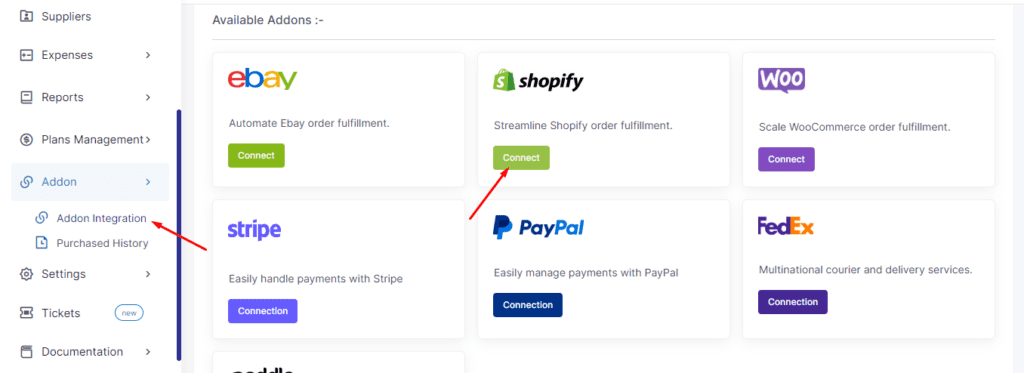
2. Once clicked, you should be prompted to make the payment and subscribe to the addon.
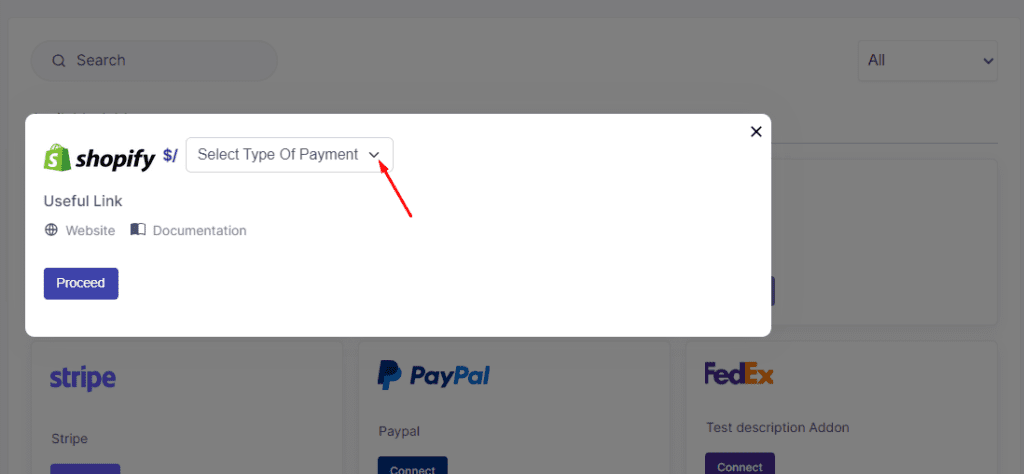
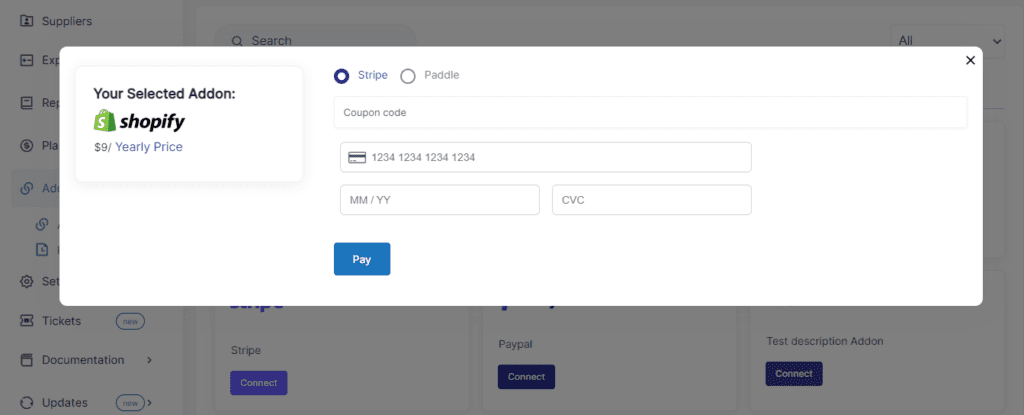
3. After clicking on the “Connect” button, you will be asked to provide your Shop Name, Shop URL, access token.
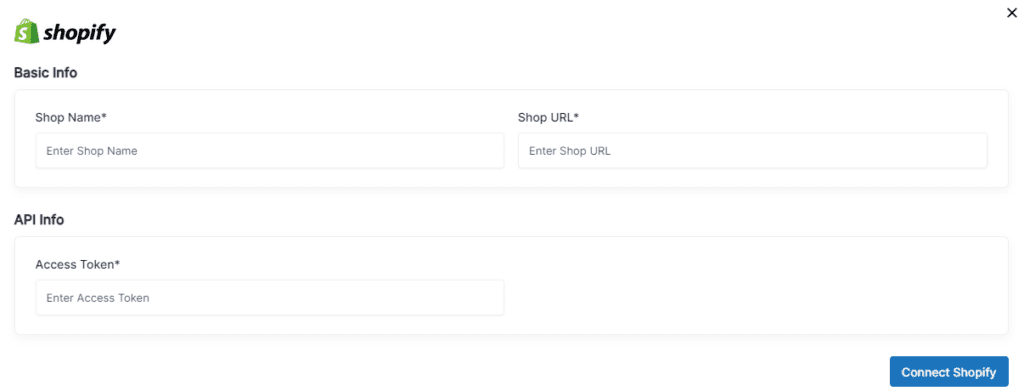
4. Now, go to your Shopify online store – Manage app – Apps & sales channels – develops app – Create an app – add name to your Shopify shop & create – API credentials – enable every field to enable API access – click on the install button – get the API ADMIN ACCESS KEY
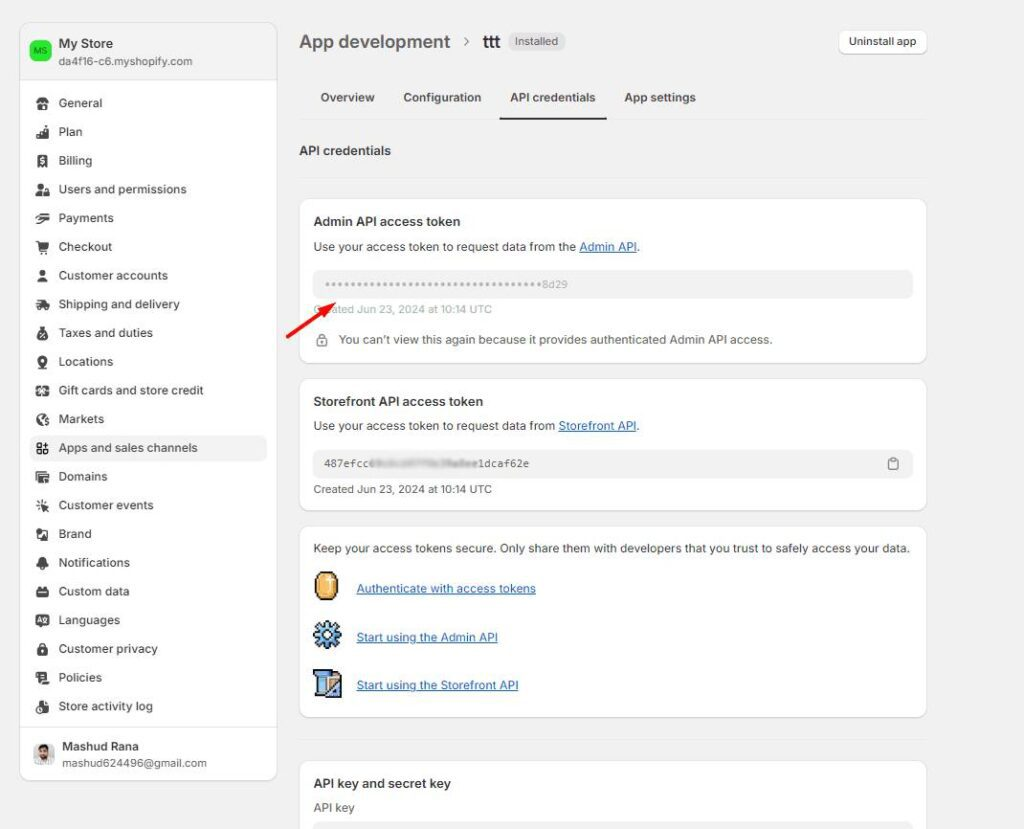
5. Now head back to your FullStro dashboard and add the required credentials to connect your store and start controlling your store from within FullStro. Once done, please press “Connect Shopify.”
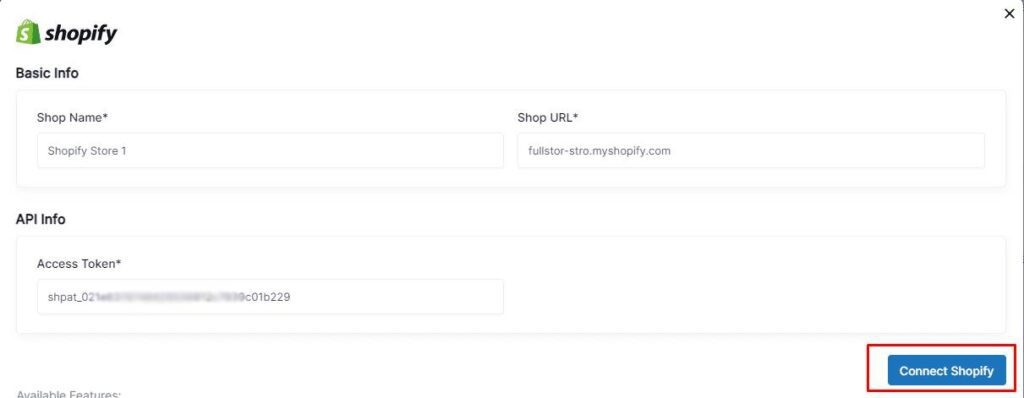
Now your Shopify store is connected to FullStro. See, it’s that easy, now, and you will be able to upload products, view orders, and control your Shopify store from FullStro.
Future Trends in Shopify Fulfillment Automation (2026 & Beyond)
Now it’s time to talk about what’s coming next in Shopify’s future!
- AI-Powered Fulfillment Predictions: Smart systems that predict what products to stock where.
- Sustainability Tracking: Eco-friendly shipping options becoming standard.
- Drone & Robotic Fulfillment: Faster fulfillment using warehouse automation and last-mile delivery drones.
- More White-Labeling Tools: Helping brands grow without revealing their third-party logistics.
The future is fast, automated, and customer-focused and the right tools will help you stay ahead.
Final Fulfillment Notes
So, after a long discussion, now we can say that if you’re still manually fulfilling orders in 2026, you’re likely spending more time and money than necessary. By automating your Shopify order fulfillment, you’ll create a smoother operation, improve customer happiness, and free yourself up to focus on growth.